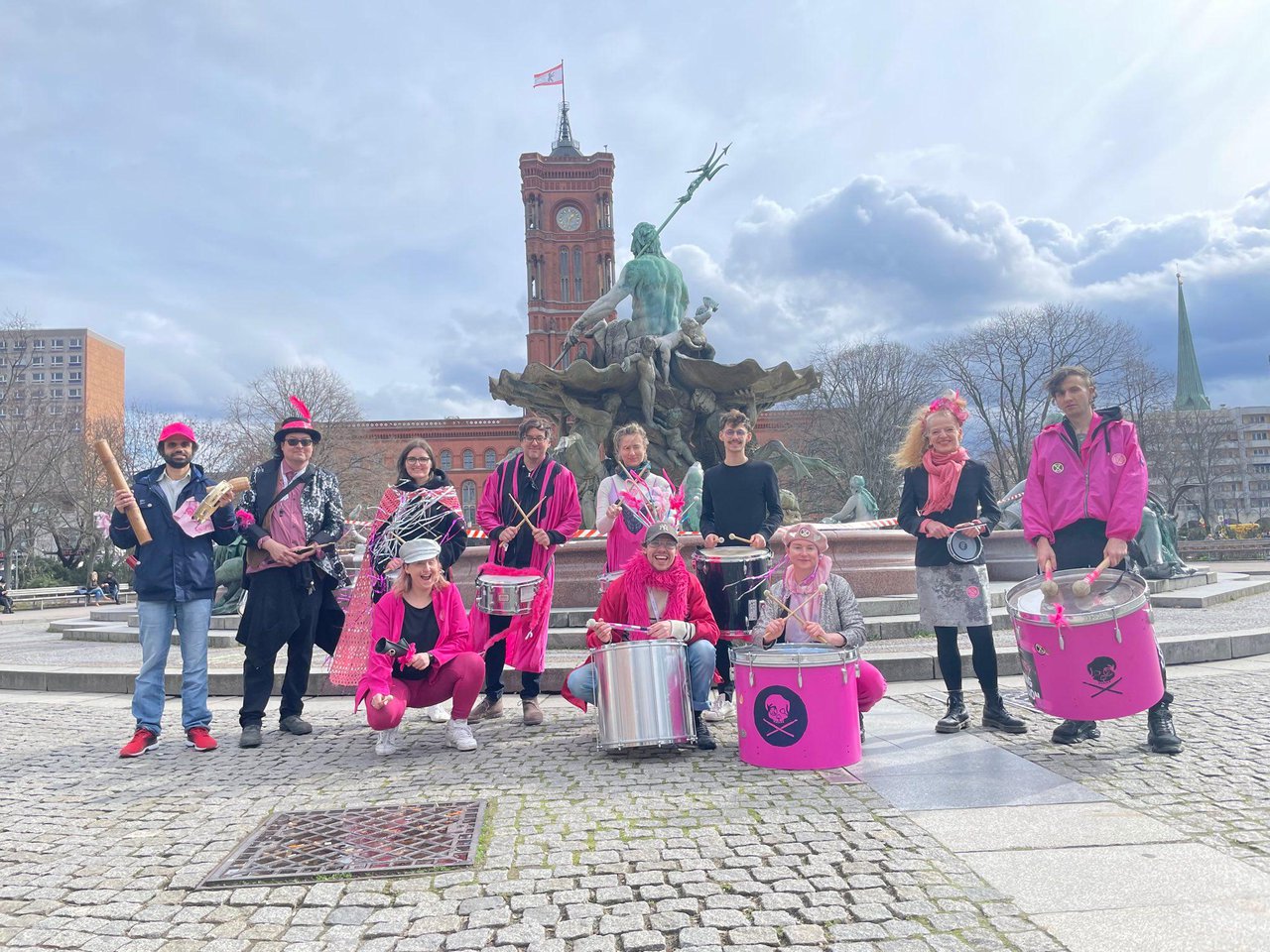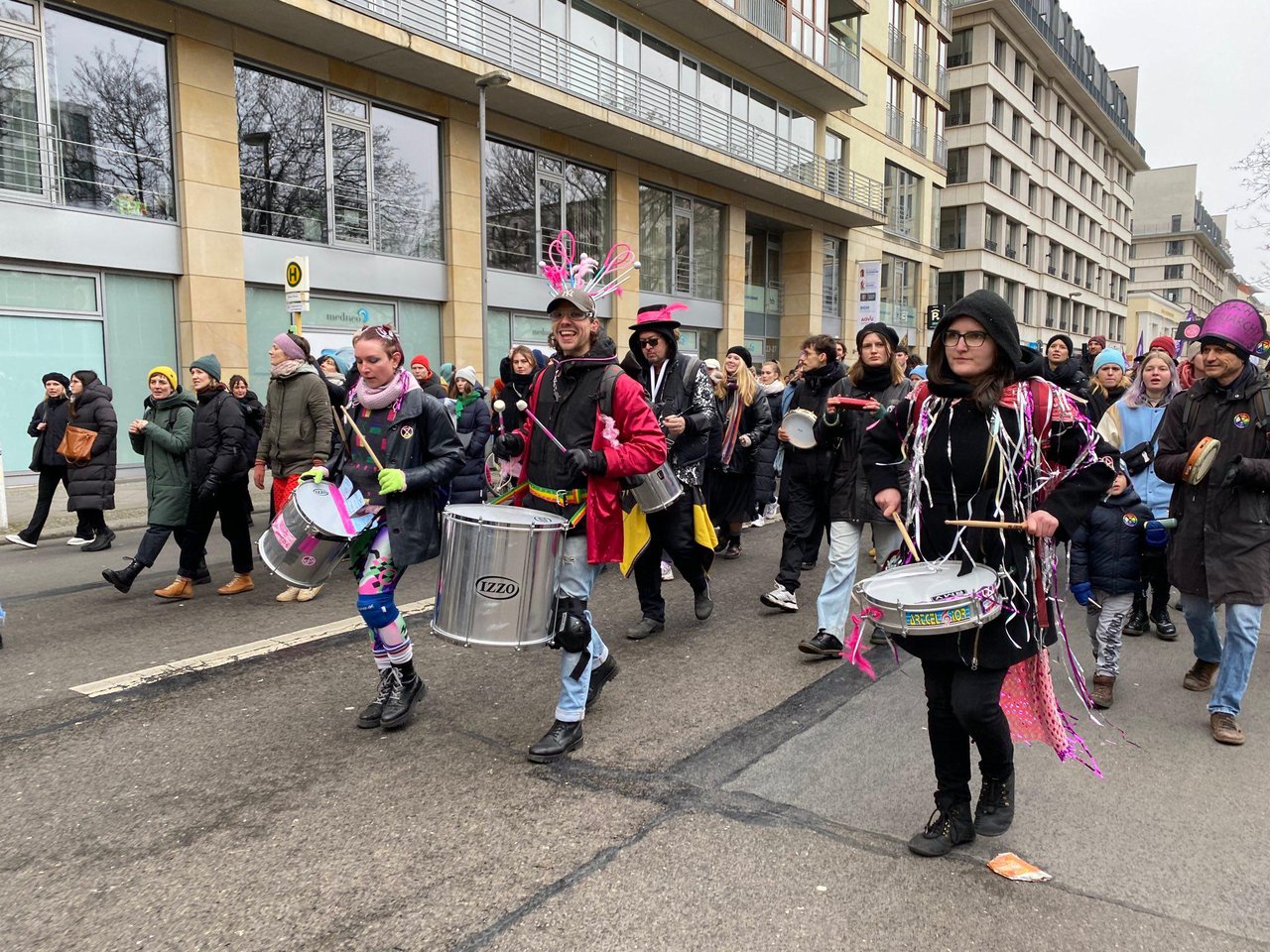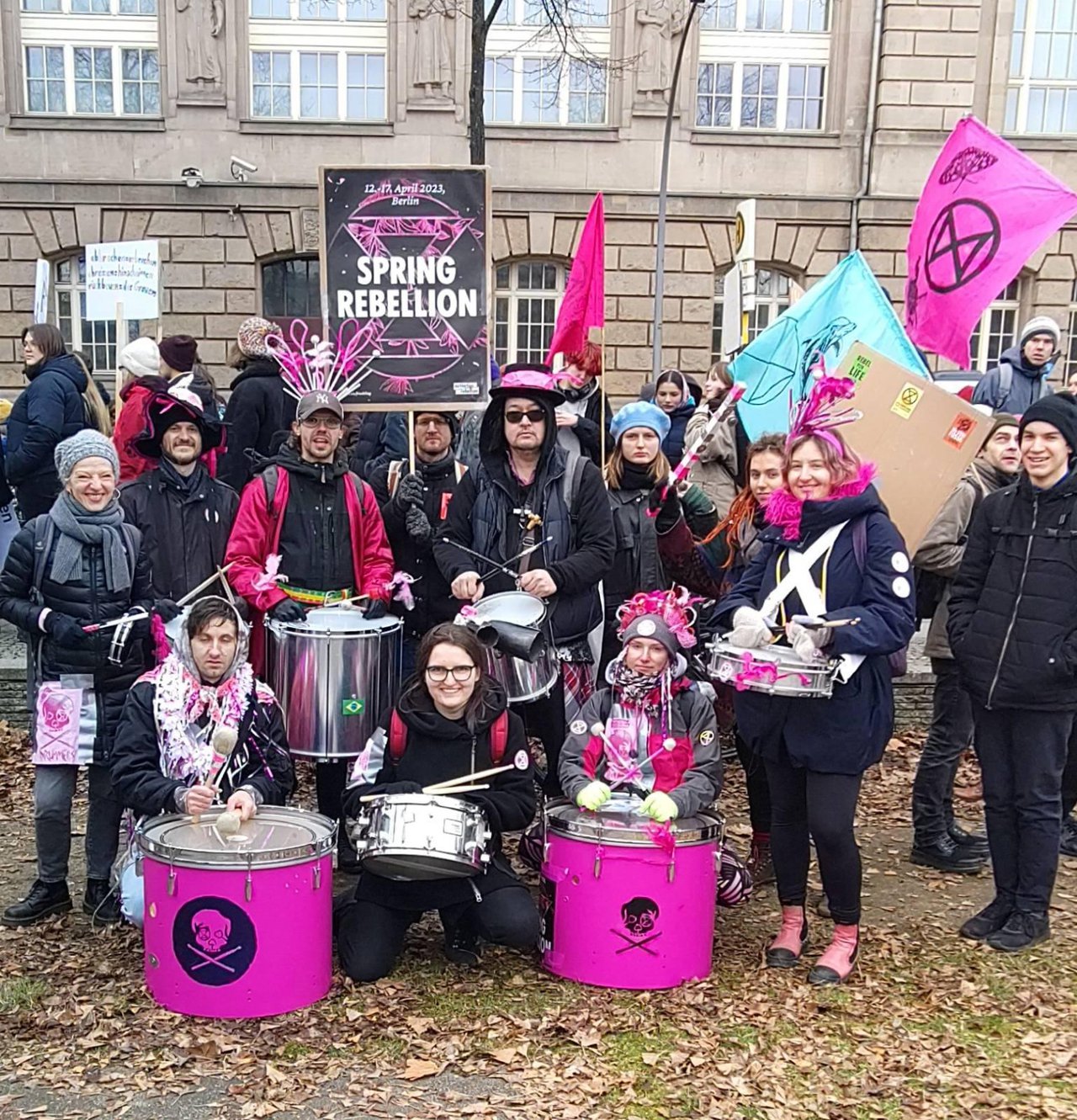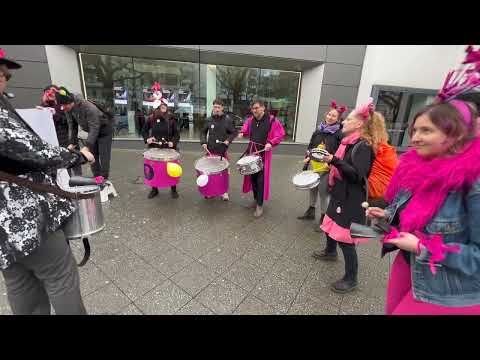
XR Drumming, what is it? Where did it come from?
In Extinction Rebellion, the main form of action is Non-Violent-Direct-Action or NVDA. This can be divided into three main categories: Disruption through mass civil disobedience; Outreach, or informing the public through protest or media; and Visioning, or demonstrating possible futures through creative action.
Drumming is a very effective, non-violent, means to achieve these ends. Unlike an electric sound system, it can be difficult for police to pinpoint and shutdown a large group of drummers. When Rebels engage in civil disobedience, drumming provides support and inspiration, sometimes from a great distance. Drumming provides a call to gather; it communicates the location of an action. When surrounded by police, the sounds of nearby drumming challenges the sense of isolation that may emerge when police close in, and it produces solidarity. Drumming signifies that an action has not been concluded, even if police have made arrests. Drumming can be used as a distraction, drawing police presence from a road blockage or allowing rebels time to set up an action in a different location. When used at a rally or demonstration, police may find it difficult to communicate due to the loud noise, but they may not want to be seen engaging in a direct confrontation with a seemingly joyful and harmless activity like drumming. In sum, the tactics used by a protest drum troupe engage the audience in a welcoming, playful, and non-confrontational way, and this confounds authorities. Drumming thus produces not only a sense of continuity and resilience for actions, it is also useful as a strategic tool. Rebels refer to such playful, non-confrontational confrontation as “tactical frivolity.”
In protests across North America and Europe today, a common site are drum ensembles playing Brazilian samba music, with or without Brazilian drums (or performing non-Brazilian music on Brazilian samba drums) - a type of ensemble called a “bateria”. The term “Batucada” is also used, though technically this refers to a subgenre of samba known for its percussive style, which draws heavily on Afro-Brazilian rhythms. Baterias emerged as a critical part of Carnival culture in Brazil, along with samba music and dance, as they developed in Carnival celebrations during the late nineteenth and early twentieth centuries. Over the past fifty years, baterias have become integral to social justice movements, first in Brazil with the bloco-afro or Afro-blocs (which promoted pan-Africanism and black civil rights in Brazil in performances in the Carnivals of the 1970s and 1980s), continuing with protests against apartheid in South Africa in the 1990s, the supporting of dockworkers’ strikes in Liverpool in the 1990s, and the challenging of IMF policies in Seattle in the late 1990s, to name a few.
The term “tactical frivolity” gained widespread use in the 1990’s, stemming from the original use of the term in academic writings on humor in the 1980’s. In Great Britain in 1991, Reclaim the Streets (RTS) emerged as champions of tactical frivolity, drawing inspiration from the Russian literary theorist Mikhail Bakhtin’s theory of Carnivalization. In medieval Carnival celebrations throughout Europe, Bakhtin argues, traditional social hierarchies were upended, familiar and free interactions between peoples were allowed, eccentricity was favored, piety towards powerful figures and symbols was scrapped, and the core dualisms of society (sacred and profane, elite and peasant) were collapsed. Reclaim the Streets organized the Carnival Against Capitalism, a prominent anti-capitalist event held in several cities on June 18, 1999, to coincide with the 25th G8 summit in Cologne. Known as J18, this event is widely credited as the first major large scale international anti-capitalist protest during the increasingly globalized period brought on by the digital age. Protests of this kind subsequently increased, most famously at the Birmingham 1998 G8, the Seattle 1999 WTO meeting, and the Prague 2000 IMF meeting.

As large-scale anti-capitalist protests grew, so did police violence. The 1999 Seattle WTO protests, in particular, saw extensive violent clashes with police, which garnered global headlines. This lead to discussion amongst activists about which forms of protest are the most useful, ethical, and successful in achieving their aims. For the 2000 IMF protests in Prague, demonstrators divided themselves into three “blocks” based upon the way they wished to engage with authorities. The “Yellow March” was reserved for traditional non-violent protestors, the “Blue March” for those wishing to physically confront the police, and the “Silver and Pink” group employed “tactical frivolity”. The “Silver and Pink” group turned out to be the most successful in terms of penetrating the security cordon around the IMF meeting. Their seemingly whimsical and playful approach confounded the police who retreated in utter confusion. Crucial for our purposes here, the Silver and Pink group included a small drum ensemble - a samba bacteria - which accompanied thirteen women from Yorkshire dressed as pink fairies who referred to themselves simply as “Tactical Frivolity”.
Ten months later, a group of protesters dressed in carnival outfits and calling themselves the “Pink and Silver” bloc, or Pink Fairies, also used the term “tactical frivolity” to describe their methods at the 27th G8 summit in Genoa. Their tactics included waving “magic fairy wands” (pink feather dusters) at the police, training “radical cheerleaders”, and deploying a “revolutionary spaghetti catapult” designed to splatter the leaders with pasta. Self-described “Carnival blocs” employing “tactical frivolity” were also prevalent at J18 in London in 1999 and Barcelona J24 in 2001. A few subsequent protests using the strategy were: the 2005 GB summit in Scotland by the Clandestine Insurgent Rebel Clown Army; the 2007 protests held concerning air travel at Heathrow, England; and the 2011 anti-cuts protests in London. During the global Occupy movement, the magazine Ad Busters (which is credited with starting the Occupy movement), overtly called for the use of tactical frivolity in protests. In sum, what we are focusing on today is the emergence of tactical frivolity over the past twenty-five years as a core mode of protest, and the use of samba baterias as a core component of this strategy.
As we explain in more detail in a moment, XR drumming derives directly from these uses of tactical frivolity. We believe the carnival block offers a way to criticize and disrupt capitalist social relations without getting locked into a dialectic of escalating physical force between young able-bodied militants and the militarized police force. Unlike the roving hit and smash squads of the black bloc tactic, or the non-violent but assertive tactics of the white blocs, the carnival bloc offers a zone through which the whole range of people regardless of their physical condition, legal status, language, or societal status can act together to challenge the power of capitalism to order our existence and destroy our environment. Tactical frivolity disrupts the “business as usual” worlds of work and consumption to liberate social space. Drawing on the idea of Carnivalization, tactical frivolity also seeks to develop a protest space of radical equality between members and a collapsing of hierarchical dualities. It moves beyond a leftist/militant approach that would emphasize “victim” status in relation to capital and instead incites (and excites) a collective realization of desires for a socially and ecologically just world.
For the rest of this article, we move in two directions. First, we provide some more detail on samba bateria drumming—and you should consider this an invitation to join our group. You are free to come to our weekly rehearsals; you are also free not to come to our weekly rehearsals once you have learned the basic rhythms. Our group is based on a set of rhythms called Rhythms of Resistance (or RoR) that we will explain in a moment - this is a codification of samba protest drumming that emerged in London circa the year 2000. Once you’ve learned the basic drum rhythms and hand signals, you are free to show up at protests with your drum (in Berlin and elsewhere), so long as there are other RoR drummers coming. We want to tell you a bit more about Rhythms of Resistance, what it consists of, and how it became a part of global protest movements. Second, we’ll conclude the talk by briefly discussing some academic research in the field of sound studies and musicology to challenge and expand activists’ framing of drumming as tactical frivolity. Is drumming actually frivolous? We will argue that drumming is by nature efficacious - by which we mean it has causal power - but it is disguised as frivolous due to definitions of music in Western culture as “entertainment.” As a type of drumming with roots in Afro-Brazilian religious culture, we suggest samba baterias obtain power in protests because they inherently draw upon a conceptualization of sound as a means of communicating across and breaking down boundaries between self and other.

Samba in Brazil
In 1685, the French King Louis XIV issued the Code Noir, which mandated the conversion of enslaved peoples to Roman Catholicism and banned the open practice of African religions in the French colonies. This had an enormous impact on French-run Saint-Domingue (the French colonial name for Haiti), as well as French-run colonial New Orleans. In New Orleans, enslaved peoples were allowed to gather and play music on Sundays, their only day off. The roots of jazz are commonly attributed to the place formerly called Congo Square in New Orleans, where West African drumming traditions and newly-arrived enslaved and free peoples of colour from various islands in the Caribbean came in the early 19th century, following the successful Haitian Revolution.
The situation was not that much different in Spanish-colonial Cuba and Portuguese colonial Brazil: African religious practices were stigmatized, driven underground, and at times, outright banned. The music associated with such traditions was generally allowed only in closed, hidden spaces. Due to the privileging of Roman Catholicism, adherents of traditional African religions were forced to adopt or make it seem like they were practicing Roman Catholicism. The Afro-Cuban religious tradition of Lucumi (also known as Santeria), the Haitian religious tradition known as Vodou, and the Afro-Brazilian religion Candomblé are all examples of fusions of largely West and Central African religious traditions with European religious iconography. In particular, West African (particularly Yoruban) spirits were commonly perceived as different versions (or aspects) of Catholic saints.
After the successful Haitian Revolution in the late 18th century, there were growing fears of slave revolts in Brazil. This resulted in increased police repression of African religious traditions. The Afro-Brazilian religion Candomblé emerged through this repression over the course of the 19th century, in the Bahia region, from the combination of Yoruban, Fon, and Bantu traditions with the Roman Catholic teachings of the Portuguese colonists. Slavery was officially abolished in 1888, and Brazil’s constitution of 1891 enshrined freedom of religion, but Candomblé remained marginalized. In the minds of elite white Brazilians, the religion was associated with criminality. In both Cuban Lucumi and Brazilian Candomblé, spirits are called Orixas or santos (meaning “saints”), and each individual is linked to a particular orixa, who is thought to be their master or “owner of their head”. Specific rhythms are played to call the orixas.
In what might be described as an early use of tactical frivolity, Candomblé rituals were often disguised as a secular party. If the police arrived, participants would claim there was no ritual happening, it was only a party. It is in such parties that samba was born. The genre combines the urban, Portuguese-influenced music of urban Rio de Janeiro in the late nineteenth and early twentieth centuries, called choro (which included the stringed instrument cavaquinho), and the drumming styles associated with Candomblé. The most famous host of such underground Candomblé events was a woman named Tia Ciata - musicians regularly met in her backyard and performed what would become samba, before the existence of radio. The first recognized samba recording, the 1916 song “Pele Telefone” by the musician Donga, is believed to have been written at one of Tia Ciata’s parties.
Today, samba baterias generally include agogo bells (which play a melody that also orients drummers to one another); the low, booming surdo drums (which play a bass line); snare drums or caixas (which typically play faster notes and improvise, holding things together), and repinique (which play a rhythm that interlocks with the rest). Added to these one may find shakers and tamborim (an instrument slightly different from a Western tambourine). In Rhythms of Resistance drumming, drummers are free to pick instruments from the Western drum kit as well, particularly snare drums, bass drums, and cowbells. Samba music basically combines these drums with the cavaquinho, though the stringed instrument is generally not present in Rhythms or Resistance.
To return to the history of samba, the genre played an important role in bringing the races together in Brazilian public space, and for this reason, it was initially looked down upon by the authorities. By the 1920s, “samba schools” had emerged in Rio de Janeiro, which were different performance troupes affiliated with different neighborhoods, called “blocs”. Getulio Vargas, the authoritarian leader of Brazil from 1930 to 1945 (and again from 1951 to 1954), found samba threatening. He decided to support samba schools so long as they put their efforts into building floats that promoted themes related to Brazilian national identity. In other words, Vargas transformed samba as a vehicle for Brazilian nationalism. This resulted also in samba being associated with tourism. By the 1950s, the genre’s popularity in Brazil was waning. In 1959, the film Orfeu Negro (or “Black Orpheus”) by the French director Marcel Camus, won the Palme d’Or award at the 1959 Cannes Film Festival and the 1960 Academy Award for Best Foreign Language Film. Many Brazilians hated the film, for they thought it portrayed Brazilians as unintelligent, naïve people who waste their lives away by mindlessly dancing samba. In his memoir Dreams of My Father, the former U.S. President Barack Obama notes that he did not share his mother’s high opinion of the film. Obama says that “I suddenly realized that the depiction of the childlike blacks I was now seeing on the screen, the reverse image of Conrad's dark savages, was what my mother had carried with her to Hawaii all those years before, a reflection of the simple fantasies that had been forbidden to a white, middle-class girl from Kansas, the promise of another life: warm, sensual, exotic, different.” Candomblé drumming, it should be noted, is present at a key moment in the film, when the main character proceeds to the underworld. Samba could have died at this moment. But surprisingly, it was reborn (or rather, returned to) being a vehicle for human rights, particularly with the bloco-afros of the 1970s and 1980s, even as it continued to celebrate Brazilian national identity in Carnaval.
It is surely the inherently participatory and joyous nature of the drumming that allowed it to be adopted in Europe and North America - boiled down to its basics, anyone can play this music, anyone’s a drummer. Although there will be a director of a samba troupe, the ensemble is by its nature non-hierarchical. In 1980, Orange Alternative formed in Poland, as part of the Solidarity campaign. Members of this group wore elf hats and incorporated Carnival culture into their protests. Some of them were arrested for attending meetings of Angry Dwarves. "The Orange Alternative" was influenced by the Russian author Mikhail Bakhtin, whose text “Rabelais and His World” deals with humor in art.
On April 1st, 1984, the London Samba School (or LSS) played its first official gig at Covent Garden Piazza. In August, 1984, they were the first Samba school to play at the Notting Hill Carnival and introduced Brazilian Carnival to the parade. Many subsequent samba groups were formed out of the LSS. Of the drummers who were founding or early members of LSS, a remarkable number are amongst the best samba, salsa, and jazz musicians in the UK. These include Joao Bosco de Oliveira (Mestre de bateria), Robin Jones (who went on to form King Salsa), Robert Pla (who formed Valdez, the first Salsa band in London), Alan Hayman, Gerry Hunt, Carlos and Pato Fuentes, Dave Patman, Liliana Chachian, German Santana, Hamish Orr, Dawson Miller and Dave Bitelli, among others. LSS can be viewed as the birthplace of samba in Europe and the school that gave rise to the European samba troupes that followed. They were also largely responsible for introducing the Brazilian version of carnival to Europe. LSS worked to maintain close connections with samba schools in Brazil; in particular, their “sister” samba school was Mocidade Independente de Padre Miguel in Rio de Janeiro (which had formed in 1955); that samba school originated from a football team called The Independent Football Club; their jersey colors were green and white and the samba troupe adopted those colors. The two schools played together in 1989 at the 3rd European Encontro in London and again for LSS 25th anniversary at Notting Hill Carnival in 2009.
Coming out of LSS, Sambatucada were a Carnival troupe who played samba rhythms. To protest Apartheid, they changed their name to Batucada Mandela, playing large rallies at 24-hour pickets and other direct actions. Before Samba troupes became popular at political protests in Britain, Batucado Mandela followed the Brazilian tradition of using samba to unify a crowd of protestors into an effective bloc. At the end of Apartheid, Batucado Mandela renamed themselves Bloco Liberdade. Their chosen colors are red and black.
In 1995, the aforementioned Reclaim The Streets was established in London, formed by the environmental group Earth First!. In 1996, Barking Bateria was formed in Barking, a suburb of greater London, by Lional Sims (a Senior Lecturer in Sociology) and Chris Knight (a Professor of Anthropology at University of East London). Both teachers were involved with The Radical Anthropology group which provided backing for the anthropology of Karl Marx and Friedrich Engels focusing on the subject of “primitive communism”. In the early-mid 90`s, Lional and Chris had seen Batucada Mandela play on the streets at one of the anti-racist marches through Hackney. Barking Bateria adopted the same colors as Batucada Mandela—Red and Black. They were also inspired by the Liverpool School of Samba and learned how to play from the London School of Samba.
The drumming that we’re bringing to XR comes directly from Rhythms of Resistance, which was formed in London in 2000. ROR formed out of a collaboration of drummers from Barking Bateria, the London Samba School, and the Liverpool School of Samba, and thus evolved directly from Reclaim the Streets. Rhythms of Resistance can be thought of as an organized system for using samba drumming at protests. Rather than simply draw on samba pure and simple, the organization produced a system of hand signals and a list of 45 rhythms signaled by the hand symbols. Thus, RoR is a new development that draws upon but is not simply equivalent to samba drumming. The rhythms are drawn from funk, rock, and hip hop, and besides samba they include several regional styles, such as the Punjabi genre called Bhangra. XR, of course, was established in Stroud, UK, in May 2018, with members of campaign group Rising Up!, which was established by Dr. Gail Bradbrook in 2016. XR Drumming was formed in summer, 2018, by the drummer Jake Slocombe, who attended an XR Intro talk at Buddhafield Festival (a Buddhist community festival near Taunton, England). Inspired by the talk, he promised to start a drumming group and bring it to the XR declaration of Independence in London. Jake lived in Tinkers Bubble, a fossil-free community near Yeovil, Somerset. He teamed up with his friend Pedro Brace and six others. With eight drummers and three rehearsals, they played to 1500 people in Parliament Square on Oct 31st, 2018, Declaration Day in London. Today in the UK, XR drumming has more than 40 groups and 700 drummers. Many new groups are forming internationally.
Conclusion
Anthropologist Laura Kunreuther [1] notes that “Political metaphors of voice are often disembodied, rarely invoked with reference to the materiality or texture of embodied voices or other actual sounds that make up democratic practice.1 In many philosophical discussions of democracy [she continues] metaphors of political voice almost always refer to discursive speech, analytic or reasoned discourse. They rarely conjure other forms for political utterance, sound, or even noise…that make up the many practices of participatory democracy.” Global protest movements today rely on social media, sound and noise, and the occupation of public space. It is time, then, to rethink notions of voice away from the disembodied notion of “I have a voice” in the singular, to the notion of collected, embodied voices, even drummed voices, sounding in public spaces and across social media.
In Western cultural history, music has often been defined as an expression of the self (of one’s emotions, or the genius of a musician or composer); music is often analyzed as a representation of culture or an individual - as an object that says something about the identity of the person or community who makes it. In religious practices the world over - particularly non-religious practices, associated (for instance) with indigenous groups, Hinduism and Taoism, Buddhism, and Sufism, and beyond - certain kinds of music have an efficacious power. They are acts that do things to change the world. In certain religions, including the Afro-Brazilian Candomblé, music is an offering to non-human gods or spirits, which is used to supplicate them, to ask for changes in the world, and/or to call them forth. Such a notion of music as an offering highlights the power of music as a crossing between self and other. Rather than a reflection of self and a subject’s emotions, music is actually a powerful way to connect with those who are not you. It is this crossing of self and other, subject and object, that Western musicology has tended to miss.
In sum, we suggest protest drumming is powerful because it harnesses this outside of the Western musical tradition - music as a powerful connecting force between self and other, that calls forth and asks for change - and it melds it to an altered conception of the voice in political democracy: the voice not as a disembodied expression of an individual or community, but voice as an audible, collective reclaiming of public space. The use of the term “tactical frivolity,” then, is tactical - for music is not frivolous but a binding agent and productive force that is useful for collective action.
[1] Kunreuther, Laura. 2018. "Sounds of Democracy: Performance, Protest, and Political Subjectivity." Cultural Anthropology Vol. 33, No. 1: 1-31.

Meet the XR Drummers at Spring Rebellion in Berlin:
- Wednesday, April 12th, 6.00 p. m.: Invalidenpark
- Thursday, April 13th, 12.00 – 4:00 p. m.: Demo of the Super Rich, through the streets of Berlin. Start: 12:00 Invalidenpark.
- Saturday, April 15th, 12:30 – 4:00 p. m.: Biodiversity Emergency demo. Start: Bayer Headquarters, Müllerstr. 178, Berlin-Wedding.
- Sunday, April 16th, 2:00 to 4:00 p. m.: Küfa (Kitchen for all. Nutrition and Biodiversity), Schlesisches Tor.
- Monday, April 17th, from 2:00 p. m.: Workshop, Invalidenpark.
